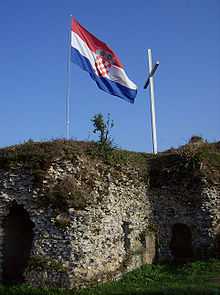Cetin Castle


The fortress of Cetin is situated 5 kilometres (3.1 mi) south of Cetingrad above the village of Podcetin, in Croatia. The time of foundation of Cetin is unfortunately still unknown. There are some indications that the settlement existed there in the times of the Roman Empire. The parish of All Saints was first mentioned in 1334. In 1387 Cetin was donated to Ivan Krčki by king Sigismund, Holy Roman Emperor and became the property of the Frankopan family.
The Middle Ages were the golden era of Cetin. Near the fortress there was a Franciscan monastery and several churches. In 15th century the Cetinski branch of Frankopan family was formed but did not last more than hundred years. Ivan Frankopan Cetinski died in Battle of Krbava field. His brother Grgur and son Franjo Frankopan became archbishops of Kalocsa. Franjo Frankopan was the last member of the family of Frankopani Cetinski. After him, the fortress became property of Frankopani Slunjski.
Cetin played an important role in the History of Croatia. After the defeat at the Battle of Mohács in 1526 Croatian nobility gathered at Parliament on Cetin (Cetinski Sabor). On January 1, 1527 they elected Habsburg Ferdinand, Archduke of Austria as the king of Croatia. The chart signed by Croatian nobles and representatives of Ferdinand of Habsburg is among the most important documents of Croatian statehood and is preserved in the Austrian State Archives in Vienna.
In the following centuries, Cetin was part of the Military Frontier, the borderland between the Habsburg Monarchy and the Ottoman Empire. During this period, Ottoman army several times took control of it . The fortress was several times damaged and repaired. Two stone plates with Arabic inscriptions in the Croatian History Museum testify about reconstructions made during this period. In 1790 Austrian troops under the command of general Walisch finally returned Cetin to the Habsburg monarchy. Siege of the fortress took one month, and after the battle several officers were decorated. One of them was also Johann I Josef, Prince of Liechtenstein. Status of Cetin was finally confirmed during the peace conference in Svishtov. In 1809 Ottoman forces once again occupied Cetin but in 1810 they withdraw under the threats of Marshal Marmont, governor-general of Illyrian provinces. When the Ottoman threat was gone the fortress was abandoned and used as quarry. Administrative control was transferred to village of Cetingrad which developed north of Cetin.
Sources
- Radoslav Lopašić: Oko Kupe i Korane, Matica Hrvatska, 1895, Zagreb
- Milan Kruhek: Cetin, grad izbornog sabora Kraljevine Hrvatske 1527, Karlovačka Županija, 1997, Karlovac
- Iz memoara maršala Marmonta: ilirske uspomene 1806–1811, Čakavski Sabor, 1977, Split
External links
Coordinates: 45°08′18″N 15°43′54″E / 45.13833°N 15.73167°E